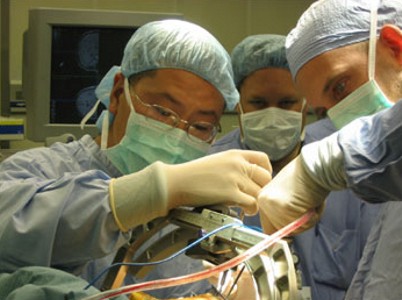.gif) VIARTIS
|
|||||
|
PARKINSON'S DISEASE NEWS |
|||||
|
|
Parkinson's Disease News covers all significant new research, reports, books, and resources concerning Parkinson's Disease. Articles are chosen on the basis of their medical significance or potential interest. Our overwhelming priority is the facts, regardless of whether they contradict prevailing views or vested interests. Analysis and further information are provided either to explain the background or implications, or to balance misleading claims. If you notice errors or inadequacies, or dispute what is written, or want to propose articles, please e-mail [email protected].
13th October 2013 - New research THE LONG TERM EFFECT OF DBS ON PARKINSON'S DISEASE Journal of the Formosan Medical Association [2013] Oct 5
[Epub ahead of print] (J.L.Jiang,
S.Y.Chen, T.C.Hsieh, C.W.Lee, S.H.Lin, S.T.Tsai)
Complete abstract
After 1 year significant improvements were seen in the UPDRS parts I, II, III, and IV and the Schwab and England scale. Five years after STN-DBS had been initiated improvements in UPDRS scores were observed only for parts II, III, and IV. In the off-medication/off-stimulation condition no significant improvement was observed. However, after 5 years there were significant deteriorations when compared to the improvements seen after 1 year in the scores for the UPDRS parts I, II, III and the Schwab and England scale. Therefore, after the improvement experienced after 1 year the long term trend is downwards. For a printable version of this article click here. For more news go to Parkinson's Disease News.
|
|
|||
.gif) |
|||||
| ©2006-2013 Viartis | |||||
| 2015-08-18 12:10:38 | |||||
| [email protected] | |||||









 The
aim of this study was to assess the improvements that can be expected after
1 year and after 5 years. Patients with Parkinson's Disease were assessed
after 1 year and 5 years according to the Unified Parkinson's disease rating
scale (UPDRS) parts I, II, III, and IV scores, the Hoehn and Yahr stage, and
Schwab and England activities of daily living (SEADL) scores in the
conditions of off-medication/on-stimulation and
off-medication/off-stimulation. Further analysis included the changes in the
L-dopa equivalent daily dose.
The
aim of this study was to assess the improvements that can be expected after
1 year and after 5 years. Patients with Parkinson's Disease were assessed
after 1 year and 5 years according to the Unified Parkinson's disease rating
scale (UPDRS) parts I, II, III, and IV scores, the Hoehn and Yahr stage, and
Schwab and England activities of daily living (SEADL) scores in the
conditions of off-medication/on-stimulation and
off-medication/off-stimulation. Further analysis included the changes in the
L-dopa equivalent daily dose. E-MAIL NOTIFICATION : If you would like to be
notified by e-mail when any new articles are added to Parkinson's Disease News, please merely
e-mail
E-MAIL NOTIFICATION : If you would like to be
notified by e-mail when any new articles are added to Parkinson's Disease News, please merely
e-mail